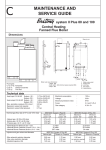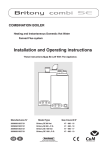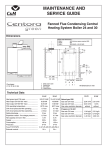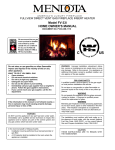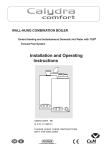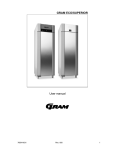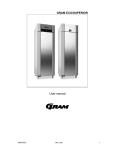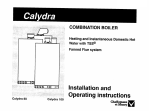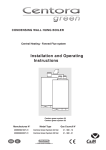Download C&M Calyadra comfort Technical data
Transcript
MAINTENANCE AND SERVICE GUIDE c Fanned Flue Combination Boiler Heating and Storage Domestic Hot Water Dimensions All dimensions in mm 360 260 50 50 212 738 850 2 3 1 4 0 bar 380 2 3 1 4 0 bar 54 54 54 54 68 c C J K L M N The boiler is suitable for the 4 flue types: • type C 12 • type C 22 • type C 32 xx or C 32 xy • type C 52 Fig. 1 Outer case dimensions : - Height : 850 - Width : 440 (minimum space required 450) - Depth : 380 I I J K L M N Safety valve outlet Heating flow D.H.W. flow Gas supply Cold water inlet Heating return Technical data Heat input C/H & DHW Cal. comfort 80 : 11.73 to 28.70 kW DHW flow rate at @ AT 30 K Cal. comfort 80 : 12.1 l/min Cal. comfort 100 : 15.43 to 31.57 kW Cal. comfort 100 : 14.1 l/min Heat output C/H & DHW Cal. comfort 80 : 9.5 to 24 kW DHW flow rate at @ AT 35 K Cal. comfort 80 : 10.4 l/min Cal. comfort 100 : 12.5 to 28,2 kW Cal. comfort 100 : 12.1 l/min Max. operating pressure C/H circuit : 2.5 bar Minimum DHW operating flow rate : 2.00 l/min Expansion vessel net capacity : 5.44 l Minimum DHW working pressure : 0.5 bar Expansion vessel initial pressure : 0.7 bar Maximum DHW working pressure : 10 bar Electrical consumption : 150 w Gas category : II 2H 3+ Voltage : 230 v Electrical protection index : IP44 Fuses : 2 A and 1.25 A Calydra. comfort 80 Calydra. comfort 100 Nominal gas flow rate at 15°C and 1013 mbar Maximum Minimum Maximum Minimum power 25,9 kW power 9.5 kW power 31,1 kW power 9,5 kW - Natural gas ( G 20) at 20 mbar 2.74 m3/h 1.00 m3/h 3.29 m3/h 1.00 m3/h - Butane gas ( G 30) at 28 mbar 2.04 kg/h 0.74 kg/h 2.45 kg/h 0.74 kg/h - Propane gas ( G 31) at 37 mbar 2.00 kg/h 0.72 kg/h 2.42 kg/h 0.72 kg/h Injectors and gas valves seat diameter - Solenoid restrictor diameter - Gas valve restrictor diameter - Manifold injectors (16) Calydra. comfort 80 Natural gas Butane or Propane 2.60 mm 1.75 mm 4.90 mm 6.70 mm 0.70 mm 1.23 mm Calydra. comfort 100 Natural gas Butane or Propane 2.90 mm 2.00 mm no resrictor required 6.70 mm 1.28 mm 0.76 mm Pump and expanssion vessel characteristics Pf le circuit chauffage (en bar) Pression à froid pour System Pressure capacity chart 2,0 Pression disponible mCE 6 1,9 Débit mini (robinets thermostatiques fermés) 1,8 1,7 4 3 1,3 1,2 2 1,1 1 0 40°C 1,6 1,5 1,4 5 100 200 300 400 500 600 700 800 900 1000 1100 1200 l/h 1,0 0,9 0,8 0,7 50°C 60°C 70°C 80°C 20 40 60 80 100 120 140 160 180 200 220 240 260 Capacité maximale de l'installation (en litres) Liters Note : The system initial pressure should be over the following value : System static height (in metre) + 0.7 = Initial pressure (in bar) 10 Head available / flow Components location 36. Gas service tap 37. Water service tap 38. CH Return isolating valve 21. DHW pressure relief valve 34. Heating Flow isolating valve 35. DHW outlet 21 Fig. 2 34 35 1. Air Pressure switch 2. Steel chassis complete with expan sion vessel 3. Fan 4. Main heat exchanger 5. Combustion chamber made of aluminium coated steel with 4 ceramic fibre panels to provide heat insulation 6. Multigas burner comprising: 6a. 16 burner head 6b. Manifold 6c. 2 Ignition electrode 6d. Ionization electrode 7. Single speed pump 8. Heating flow switch 9. Automatic air separator and autimatic vent 10. DHW thermistor 36 37 11. Sealed chamber 12. Electrical box 13. Overheat safety cutou 14. Gas section comprising: 14a. Security valve (grey) 14b. 1/3 gas stage (blue) 14c . 2/3 gas stage (black) 15. TSS mini cylinder 16. Central heating control thermistor 17. Three way valve 18. TSS thermistor 19. DHW flow switch 20. Secondary heat exchanger 23. Two position selector switch 24. DHW temperature adjustment 25. Heating flow temperature adjustment 26. Heating temperature indicator lights 27. Green indicator - Power ON 2 38 28. Orange indicator - Burner ON 29. Red indicator - Lock out / flame failure 30. Reset button 31. Pressure gauge 32 DHW mode indicator 33 Heating mode indicator 50. Adjustable by-pass 51. connecting bracket 52. 45° elbow including ventur 53. Expansion vessel (not visible) 54. Right hydraulic assy 55. Left hydraulic assy FUNCTIONING 52 1 2 3 4 11 5 6 Switching on 1) Check that the gas service tap is opened at the gasmeter and main power is on. 2) Check that pressure in central heating system is above 0.7 bar and below 1.5 bar with the pressure gauge 31. 3) Open the gas tap 36. 4) The boiler is now ready to use. 5) Turn main switch 23 to position I . The green "power on" indicator 27 will light. Hot Water 1) Turn the DHW temperature control knob clockwise 24. The DHW indicator will light 32. 2) Turn on a hot water tap, the orange "burner on" indicator will light 28 and the water will become hot.. Heating 20 1)Turn the CH thermostat control knob clockwise 25 The CH indicator will light 33. 2) If the room thermostat (if fitted), the boiler temperature control 9 and the clock (if fitted) are all calling for heat, the orange "burner on" indicator will light and the heating will be on. 54 26 10 Control panel 28 27 30 29 14 15 13 55 17 8 33 32 reset 12 I 19 7 18 Fig. 3 Fig. 4 31 25 24 23 CALYDRA FUNCTIONAL DIAGRAM 52 3a 1 4 5 6c 6d 6 53 13 14 a 12 c b 10 18 16 8 19 15 17 9 7 20 50 34 37 35 36 38 21 51 Hot water mode Fig. 5 3 Heating mode Fig. 6 When there is a need for hot water while the heating is on, it is only necessary to turn on a hot tap. The heating will be interrupted momentarily while the hot water is being delivered. The boiler will switch back automatically to heating when the tap is turned off. Note: If the boiler has been turned off for some time the first attempt to light it may result in a lockout If this happens press the reset button 30 and the boiler will light. To Turn Boiler Off Completely 1) Turn the main switch 23 to the off position O. 2) Turn the gas tap 36 (fig.2) OFF. Domestic Hot Water Mode In order to supply hot water, the main switch 23 (fig. 4) must be in ON position I. This will be confirmed by the green indica27 (fig. 4). Turn DHW tempertor light ature adjustment knob 24 clock wise to establish the green DHW indicator 32 (fig. 4). The hot water temperature in the mini cylinder can be adjusted between 40 and 60°C using control knob 24 (fig 4). When a tap or shower is turned on, the flow of mains water, above 2 litres per min., will activate the 3 way valve 17 (fig. 4) to move to the DHW position. The pump will now circulate primary water heated by the main heat exchanger through the secondary heat exchanger. The first stage solenoid a (fig. 6) and safety solenoid c (fig. 6) open together to allow gas to the burner. The ignition sequence begins and a continuous high speed spark ignites the gas. As soon as a flame is 28 detected the orange indicator bulb (fig.4) will light and the second stage solenoid b (fig. 6) opens to allow the full gas rate. If a flame is not detected, after 8 seconds, the security solenoid closes and shuts off the gas. The red lockout indicator bulb 29 (fig.4) will show. Over 2 l/min, the domestic hot water temperature is controlled by the hot water control thermistor 9 (fig.6) and the heating control thermistor 16 (fig.6), but dependant upon to the position of the DHW temperature adjustment knob 24 (fig.4). This system anticipates the changes of temperature in the secondary heat exchanger and ensures accurate temperature regulation. When the tap is closed the burner is extinguished and the pump stops. (unless the mini cylinder thermistor is calling for heat, in which case the burner will remain on at a low rate and the pump will continue running until the mini cylinder thermistor is satisfied). The boiler will now stay in the hot water mode for 30 seconds to be ready for a subsequent draw off Priority is given to a demand for hot water. This will interrupt the central heating for the duration of hot water delivery or recovery of the mini cylinder. When the boiler has been in standby in Hot Water Mode for some time or when drawing DHW at flow rates of less than 2 l/min the temperature in the mini cylinder will eventually decrease and the TSS® control thermistor 18 (fig.6) will call for heat. Bringing the pump and burners to operate, until the cylinder thermistoris satisfied. this is quite normal. WIRING DIAGRAM 4 Central Heating Mode To be able to supply heating, the main switch 23 (fig.4) must be in I position. This will be confirmed by the green indicator light 27 (fig.4.) Turn the temperature control knob 25 clock wise to establish the green heating indicator 33 (fig.4). When there is a demand for heating (either from the room thermostat or the clock) and the boiler temperature control is calling for heat. The pump starts allowing the ignition sequence to begin. The first stage solenoid a (fig.6) and safety solenoid c (fig.6) open together to allow gas to the burner. The ignition sequence begins and a continuous high speed spark ignites the gas. As soon as a flame is detected the orange indicator bulb 28 (fig.4) will light. After 45 seconds the second stage solenoid b (fig.6) opens to allow the full gas rate. If a flame is not detected, after 8 seconds, the security solenoid closes and shuts off the gas. The red lock29 (fig.4) will show. out indicator bulb The central heating flow temperature is controlled by the central heating control thermistor 16 (fig.6). The boiler has been designed to minimise cycling and will not attempt to relight for at least 3 minutes after the boiler thermostat has been satisfied (it is possible to reduce the time to 30 s if necessary). When the room thermostat is satisfied the burner will switch off and the pump will remain running for a further 4 minutes before it to stops. NB : It is possible to override the 3 minute delay by pressing the RESET button 30 (fig. 4) ADJUSTMENTS ON CONTROL PCB Adjustment on the PCB : P3 Cycle) - P3 : potentiometer TAC (Temporisation Anti1/3 may now be adjusted between 30 seconds and 3 minutes (see detail) (factory set at 3 minutes). 1 2 J2 C10 R72 P3 C11 - JP3 : the spade connector allows the gas rate to be reduced to 1/3 performance by positionning spade across pins as shown A Full performance across pins as shown B.(factory set) J5 J1 HOR R73 C38 R75 R76 After completling adjustments replace rubber cover and refit outer casing MV1 A B P3 R85 1/3 mini Temperature regulation for both C/H and DHW circuits are controlled by 2 thermistors. The C/H knob allows the adjustment of temperature between 35 and 85°C. The DHW temperature is limited to 60°C. DHW and C/H thermistors are identical and interchangeable. Resistance value are -5000 Ω at 25 °C 40°C -2631 Ω at 80°C -620 Ω at 110°C -255 Ω at AIR PRESSURE SWITCH The air flow rate is detected by a pressure differential created by a venturi located in the flue duct. F1A 3/3 Detail ROUTINE SERVICING REGULATION ∆P > 130 Pa ∆P < 100 Pa F1 maxi P3 (P3-P4-P5) ON threshold OFF threshold P3 R67 JP3 To ensure continued efficient operation of the appliance, it is recommended that it is checked and serviced as necessary at regular intervals. The frequency of servicing will depend upon the particular installation condition and usage, but in general, once a year should be adequate. P3 It is the law that any service work must be carried out by a competent person such as your local Chaffoteaux Service Centre, British Gas or other CORGI registered personnel in accordance with the current Gas Safety (Installation and Use) Regulations. The service schedule should include the following operations: - Check the pressure in the system. - Check the correct operation of the appliance. - Check the correct operation of the gas controls. - Check the functions of the safety controls. - Check combustion chamber insulation panels for damage. - Clean the burner. - Clean the heat exchanger. - Check the burner manifold injectors. - Clean gas and water filters. - Check expansion vessel charge pressure. - Clean and check operation of safety valve. Additional Procedures that may be necessary: - Check burner pressure and gas flow rates. 5 - Check that the fan blades are clean. - Check, clean and replace components as necessary. - Carry out combustion test utilising the test points in the flue turret. SUGGESTED SEQUENCE for SERVICING 3/3 Before disconnecting or removing any parts, isolate the gas and electricity supplies. Ensure that the appliance is cool. (for detail please see section on Parts Removal and Replacement) Preliminary Checks - Remove outer case - Check the system pressure is at least 0.8 bar cold - Check operation of solenoids. - Check that the burner is extinguished fully when solenoids are closed in both DHW and C/H modes. - Test ionisation functions and check that lockout occurs by turning off gas tap. REMOVAL AND REPLACEMENT OF PARTS Before removing appliance case, isolate the gas and electrical supplies. Isolate boiler from the system and drain before removing any component in the waterways. Ensure that the appliance is cool. 1. Outer Case Remove four screws in base of case and 5. Ignition Electrodes Carry out steps 1 and 2 as above. remove the wiring cover undo the power lead plug open the electrical box 2 clips. Dicconnect leads from spark generator on PCB. Loosen screws securing the closure plate and remove. Remove grommet from base of sealed chamber. Remove screw securing electrode bracket and lift clear easing spade connectors through the grommet. Reassemble in reverse order, twisted together electrodes cable at least 10 times to avoid electrical interference. Remove outer case and sealed chamber front panel as in steps 1 and 2. Disconnect three pressure switch cables noting their positions. 1 = white cable connected to NC 2 = black cable connected to NO P = orange cable connected to C Remove screw securing the switch bracket to the chassis. Disconnect the sampling tubes again noting their positioning (+ and -). Remove switch. Reassemble in reverse order. 6. Burner Assembly Carry out steps 1,2, disconnect electrodes as mentionned in section 4 and 5. Remove two screws securing burner assembly to the back panel of the boiler. Lift right hand back corner first. Reassemble in reverse order. 11. Pressure Switch Venturi Carry out steps 1, 2 and 8, as above. Disconnect the sampling tubes and remove the screw securing the venturi to the flue outlet. Remove venturi by the bottom of the 45° elbow. Reassemble in reverse order. 2 3 1 4 0 bar A A A A lift free. When replacing, carefully locate on lugs B on top edge of chassis. B B 1 2 3 2. Combustion Chamber Unscrew four self tapping screws securing the sealed chamber front panel and lift over top corner locating lugs. Unscrew four self tapping screws to release combustion chamber front plate and lift clear. Reassemble in reverse order. 7. Gas Solenoids Disconnect colour coded leads. Remove six screws. The solenoids are attached to their base plate. Lift clear taking care not to lose the three plungers and springs. Reassemble in reverse order replacing the cork gasket. 8. Fan Assembly Remove outer case and sealed chamber front panel (See Steps 1 and 2). Disconnect spade connectors noting positions. Remove two screws securing the front of the fan assembly and loosen screw on flue outlet. Twist fan assembly anticlockwise to disengage from flue outlet and lift clear. Re-assemble in the reverse order ensuring that the wiring is re-connected correctly and the screw on the flue outlet tightened. 9. Flue Hood Carry out steps 1 and 2 as above. Remove fan assembly as in step 8. Remove the three screws securing the angled top of the hood to the chassis. Lift and remove taking care not to snag the pressure switch cables. Re-assemble in the reverse order ensuring that the hood is located behind the combustion chamber rear panel. 10. Pressure Switch 3. Burner Manifold Carry out steps 1 and 2 as above. Remove two screws securing the closure plate and the remaining four screws to release the manifold. Lift clear. Replace the manifold gasket. Reassemble in reverse order. 4. Ionisation Electrode Carry out steps 1 and 2 as above. Loosen screws securing the closure plate and remove. Disconnect the lead from the main wiring loom. Remove screw securing electrode to burner. Thread wire through grommet and lift clear. Reassemble in reverse order. 1 2 12. Drain down 2 drain (air separator) 2 1 points are located on the boiler. 1 = DHW circuit drain point 2 = Heating circuit drain point (Pressure releave valve) 13. Water filters ( Heating and DHW) The C/H filter ensures a seal between the return tail and the tap 5 Fig. 2 unscrew the pipe nut and the tap nut. Pull the tap toward you and remove the C/H filter. The DHW filter is located in the DHW command 37 Fig. 2 on the right hydraulic assembly. Remove the clip and pull toward you the DHW command remove the plug and clean the filter. Reassemble in reverse order. 14. DHW Flow switch Disconnect the electrical connections undo the securing clip and remove the microswitch reassemble in reverse order. 15. Pressure relief valve Drain the boiler first, unscrew the safety valve head with a 24 mm spanner. Reassemble in reverse order. P 6 16. 3-Way valve Drain boiler as in step 12. Remove the 2 clips on the 3 way valve hydraulic motor 17 (fig. 6). Pull up the motor .Turn anticlockwise the 3 way valve body, rise it up using a screw driver and remove it. Reassemble in reverse order. 20. Pump Drain the boiler as in step 12. Open the electrical box cover removing the 2 screws. Remove the main lead connection. Open the electrical box, 2 clips G F 17. Secondary heat exchanger 20 G D Drain both circuits of the boiler as in step 12. Unscrew the 2 fixing screws D and remove the DHW exchanger from the front. Prior to reassembly, check that the 4 gaskets are correctly positioned. The heat exchanger is so designed that it cannot be remounted incorrectly. 18. Main heat exchanger H Remove the pump plug from the control board and earth plug from earth socket. Pivot the electrical box downwards. Unscrew the nut F of the flow pipe from the volute. Remove the clip H on the pump volute and pull pump toward you. Remove the back clip. Reassemble in reverse order. 21. Thermistors Drain the boiler as step 12. Disconnect the plug, remove the retaining clip pull the thermistor out Reassemble in reverse order. 10 16 18 E Carry out steps 1 and 2 as above. Drain boiler as in step 12. Remove the 2 clips E located on return and flow pipes and pull them downwards. Pull the main exchanger toward you to remove. Reassemble in reverse order 19. Expansion vessel Remove the casing as step 1 and drain the boiler as step 12 above. Unscrew the connecting nuts and lift out the boiler from the wall. Place it on a side on the floor. Remove the expansion vessel bracket retaining screws, disconnect the pipe from the vessel and pull it toward you. Reassemble in reverse order. 13 24. R2i mini cylinder You have to remove the hydraulic bloc. Carry out steps 1 and 2 as above. Drain the cylinder by removing the drain plug J. Remove the 3 way valve as in step 16. Remove all the connections of main wiring. Remove the lid of connections box K. Disconnect the pump from electronic circuit. Remove the manometer. Unscrew the nut L of the pipe between the pump and the primary heat exchanger. Remove the gas pipe by unscrewing the two nuts M. Remove the gas block by removing the 4 screws. Unscrew the last nuts of connection from the pre-installation gig. Remove the two fastening screws of the hydraulic block from the frame. Pull all the hydraulic block toward you by inclining it slightly. Remove the two clips. Unscrew the two nuts fixing the cylinder. Reassemble in reverse order. M 10 = DHW thermistor 16 = Heating thermistor 18 = TSS thermistor 22. Control board Carry out step 1, open the electrical box cover as mentionned in step 5. unplug all cables from the PCB remove earth plug from earth socket undo the screw fixing the PCB. Hang out the control board. Reassemble in reverse order. 23. Safety thermostat Remove the casing as step 1 unscrew four self tapping screws securing the sealed chamber front panel. Disconnect the 2 cables, pull out the sensor with the clip 13. Reassemble in reverse order. 7 K J L 8 Release pump rotor The display flashes on 50. Replace the heating flow switch Replace the DHW flow switch Replace the PCB No - Check mains inlet connection - Check internal fuses - Check main switch on PCB No No No No Ok Yes Yes Replace the PCB Ok Replace pump Ok Check that the pump spins free Ok Check voltage in the pump electrical box Ok Check heating flow switch Ok Check the DHW flow switch Ok Yes Does the red LED alight ? No No Please refer to the error list and solve the problem Press on reset button to make a new self test and reset Does the green LED alight ? Put the main switch on 1 No Does the display Flashe? Replace the fan Replace the PCB or the wiring The display flashes on 40/60/70. Replace the air pressure switch. The display flashes on 50/70/80 or 50/60. Replace the heating thermistor Yes No No No No Yes The display flashes on 60/70/80. Replace heating flow switch, or Check the plates exchanger (Scaled) Does the pump run ? Draw of Domestic Hot Water with a flow of 3 l/min, Switch the Domestic Hot water mode on and turn DHW on Ok No means a group of actions means an action means a test or a choice Check if there is voltage at the fan No Check if there is voltage at between connectors P and 1 Ok Check contact of air pressure switch between P and 1 Check the heating thermistor switch Check heating flow No Does the fan run ? Replace spark generator or ignition electrods assembly The display flashes on 40/60/80 The fan stops after 45s - Check pressure probes or - Check Flue duct condition or - Replace pressure switch Yes Yes No Anytime the display can show an error code, Please try to solve the problem and then press Reset to make a new self test and start the boiler again Replace PCB Does the spark generator energize Ok Check contact of air pressure switch between P and 2 Could you ear the spark generation? PLEASE CHECK CAREFULLY FOLLOWING POINTS BEFORE GOING THROUGH THE FAULT FINDING CHART -Gas pressure -Electric mains -Minimal water pressure in the heating circuit (over 0.8 bar) - All isolating valves opened - Boiler air vented -Minimal domestic hot water flow of 2 l/min at 0.5 bar -Check that the heating filter is cleaned. - Put all buttons on OFF position (turn them anticlockwise) FAULT FINDING CHART Part 1 Yes Please go to the next page 9 Replace electrod assembly Replace gas solenoïds assembly Replace PCB Replace PCB Check the wire or replace overheat sensor Replace PCB From the previous page 8 No No No No No Yes Replace PCB Ok check the ionization electrod Yes Is there a gas pressure at manifold ? Yes Does safety gas solenoïds energized ? Yes Purge gas pipes and press on reset button Yes Does the red LED alight and 70/80 ? Does the red LED alight and 80 ? No Does the burner alight more than 6 sec.? No Does the orange LED alight ? Yes Replace the domestic hot water heat exchanger or the main exchanger No Does the DHW temperature rise ? Yes Replace DHW thermistor - Rotate counter to clockwise potentiometer close DHW to the minimum. - Adjust the DHW flow rate at 3l/min on a tap. - Wait until the temperature becomes stable. FAULT FINDING CHART Part 2 No Replace PCB The display flashes on 40/50/60/80 Check or replace the 3 ways valves Replace PCB Ok Check DHW thermistor Yes Does DHW temperature over 50°C ? No No No No The boiler is OK Yes Does heating LEDs alight ? Yes Does the heating outlet pipe temperature rise ? Yes Does the orange LED alight ? - Press on RESET button to cancel all delays. - Insure that external controls are calling for heat. - Switch OFF the DHW mode, - Rotate clockwise the heating potentiometer to maximum position, Stop to draw water at the tap INCORRECT FUNCTION Incorrects functions is signalled by leds (rep 26) display flashing correspond with chart below. CODE 30 40 50 60 70 80 m m m m m l m m m m m m m m m m m m m m m m m m m m m m m m m m m l l l l l m m m m m m l l l l l m m l l l m m l l l l m m m m l l l m m l l l m m l l m m l l m m l m l m m l m l m l m l m l m l m l m l FAULT INFORMATION Overheating safety feature Overheating defect without locking Misfiring safety feature Fire detection without burner working Besides freezing pump Besides freezing burnerr Lack of water circulation. Primary water circulation defect Thermistor sanitary open Thermistor sanitary bypassed. Thermistor inlet heating open Thermistor inlet heating bypassed Extractor on and pressure regulator at rest Extractor off and pressure regulator at rest Thermistor cylinder open Thermistor cylinder bypassed Distribution valve stuck on heating m = LED off l = LED blinking 10 SHORT LIST 627 104 110 402 629 111 588 505 572 113 615 514 607 636 605 206 532 606 216 938 Key N° Description G.C N° Manf. Pt. N° Type CA LY CA DRA LY C DR OM F A CO ORT MF OR T 80 100 FF FF 104 110 111 113 OVERHEAT THERMOSTAT 100°C IGNITION ELECTRODE IONIZATION ELECTRODE HEAT EXCHANGER HEAT EXCHANGER 206 216 277783 277788 277789 277790 E00606 FAN ASSY AIR PRESSURE SWITCH 24KW AIR PRESSURE SWITCH 28KW 402 505 514 532 588 572 SOLENOID VALVES KIT THREE-WAY VALVE E23494 E23510 WATER / WATER HEAT EXCHANGER WATER THROTTLE 277846 AIR SEPARATOR HEAD ASSEMBLY PUMP + AIR SEPARATOR 15/50 PUMP + AIR SEPARATOR 15/60 605 606 615 627 629 607 636 938 CONNECTOR CONNECTOR PRINTED CIRCUIT BOARD FUSE 250V 2A - TEMPORIZED FUSE 250V 1.25A - TEMPORIZED PRESSURE GAUGE KNOBS SET PRESSURE RELIEF VALVE 277883 277884 1010572 1002801 1002802 1010017 1011136 1304720 1306697 1307335 81836 81839 1302409 81471 1304608 1301964 1303461 1302101 1303697 1307627 1003456 1003635 1303159 81979 1020933 NAT 11 .. .. .. .. .. . . .. .. .. .. .. .. .. .. .. .. .. .. .. .. .. Manf. date from to This appliance is suitable for Natural gas or LPG. A gas conversion must be made by a competent person. Manufacturer: Chaffoteaux & Maury - France Commercial subsidiary: MTS (GB) Limited MTS Building Hughenden Avenue High Wycombe Bucks HP13 5FT Telephone: Fax: Internet: E-mail: (01494) 755600 (01494) 459775 www.chaffoteaux.co.uk [email protected] Technical Support Help Line: Customer Service Help Desk: 0870 241 8180 0870 600 9888 Ref. : 1309148c - 06/2004 Chaffoteaux & Maury are continuously improving their products and therefore reserve the right to change specifications without prior notice and accepts no liability for any errors or omission in the information contained in this document.












